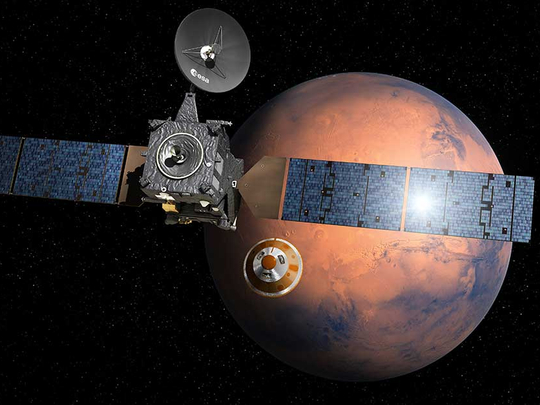
Darmstadt: Ground controllers on Wednesday celebrated placing a European-Russian robot explorer in Mars’ orbit, but faced an anxious wait for news of the tiny lander it had despatched to the Red Planet’s surface.
The paddling pool-sized “Schiaparelli” lander, a trial-run for a Mars rover to follow, was scheduled to land at 2.48pm GMT (6.48pm UAE) after a scorching, supersonic, dash through the thin atmosphere.
But the craft’s signal disappeared towards the end of its six-minute descent, evoking the ghost of Europe’s first effort to land on Mars 13 years ago, when the British-built Beagle 2 robot lab was lost.
“It’s clear these are not good signs,” ESA operations head Paolo Ferri said at ground control in Darmstadt, Germany on Wednesday. “But we need more information” before declaring Schiaparelli lost.
There could be “many, many reasons”, for its silence, said Ferri.
It could mean the lander had exploded in the atmosphere or crashed on the surface, but also that it landed safely and was simply having trouble communicating.
The next update would be given at 8am GMT (noon UAE) on Thursday.
Schiaparelli and its mothership, the Trace Gas Orbiter (TGO), comprise phase one of the ExoMars mission through which Europe and Russia seek to join the United States in probing the harsh Martian surface.
The pair had travelled seven months and 496 million kilometres from Earth.
Schiaparelli’s experiences were meant to inform technology for a much bigger and more expensive rover scheduled for launch in 2020 - the second phase and high point of ExoMars.
The rover will be equipped with a drill to seek out clues of life, past or present, up to a depth of two metres.
Vital signs
The TGO, in turn, will aid the search for life by sniffing atmospheric gases potentially excreted by living organisms - however small or primitive.
Its science mission will start in early 2018.
Ground controllers cheered and clapped when it was confirmed Wednesday that the TGO had entered into its intended orbit around Mars, some 170 million kilometres from Earth.
“It’s a good spacecraft in the right place, and we have a mission around Mars,” flight operations manager Michel Denis announced in Darmstadt.
Schiaparelli’s silence put a dampener on the celebrations, though ESA officials tried to look on the bright side.
“Whatever is going to happen, we will have learnt a lot of things because we will have data recorded of the descent,” spokeswoman Jocelyne Landeau-Constantin told AFP.
“So, we already have quite a bit of lessons learnt.”
And ESA director-general Jan Woerner added: “This is typical for a test.”
“We did this in order to get data about how to land with European technology on Mars, therefore all the data we will get this night... will be used to understand how to manage... the next landing when we’re going with the rover.”
For a safe landing, Schiaparelli had to brake from a speed of 21,000 kilometres (13,000 miles) per hour to zero, and survive temperatures of more than 1,500 degrees Celsius (2,730 degrees Fahrenheit) generated by atmospheric drag.
It was equipped with a discardable, heat-protective “aeroshell” to survive the supersonic jaunt through Mars’ carbon dioxide-rich atmosphere.
It had a parachute and nine thrusters with which to brake its fall, and a crushable structure in its belly to cushion the final impact.
Schiaparelli had been free-falling to Mars’ surface since Sunday, when it separated from the TGO.
While life is unlikely to exist on the barren, radiation-blasted surface, scientists say traces of methane in Mars’ atmosphere may indicate something is stirring under the surface - possibly single-celled microbes.
Since the 1960s, more than half of US, Russian and European attempts to operate craft on the Martian surface have failed.












